The Ultimate Guide to Choosing Disposable Food Trays
What are Disposable Food Trays?
- Paper Food Trays
- What are the Common Paper Food Tray Sizes
- What Factors Affect the Size of Paper Food Trays
- The Advantages of Paper Food Trays
- The Disadvantages of Paper Food Trays
- Foam Tray
- What are the Common Foam tray sizes
- The Advantages of Foam Trays
- The Disadvantages of Foam Trays
- Plastic Food Trays
- What are the Common Plastic Food Trays Sizes
- The Advantages of Plastic Food Trays
- PLA Trays
- What are the Common PLA Trays Sizes
- The Advantages of PLA Trays
- The Disadvantages of PLA Trays
- Compostable Trays
- What are the Common Compostable tray sizes
- The Advantages of Compostable Trays
- The Disadvantages of Compostable Trays
- Aluminum Foil Trays
- What are the Common Aluminum Foil Trays Sizes
- The Advantages of Aluminum Foil Trays
- The Disadvantages of Aluminum Foil Trays
How to Choose the Right Disposable Food Trays for Your Business
Now, many restaurants are abandoning reusable food trays and starting to use disposable food trays to meet a variety of needs. Today, let us take a look at the common disposable food trays on the market and their various characteristics, this will provide you with a lot of information when choosing and wholesale food trays.

What are Disposable Food Trays?
Disposable food trays are a type of shallow and flat food containers, they can be made from different materials in various shapes and sizes. Disposable compartment trays are another name for these food trays since they are normally designed to hold individual portions of food or snacks. Of course, some designs do not have compartments, which need to be based on specific needs.
The main appearance features of the disposable food tray are flat bottom and raised edges or rims, this design can hold the food and prevent spillage or leakage.
Types of Disposable Food Trays
As mentioned above, disposable cafeteria trays can be made from different materials. let’s take a look at who are they.
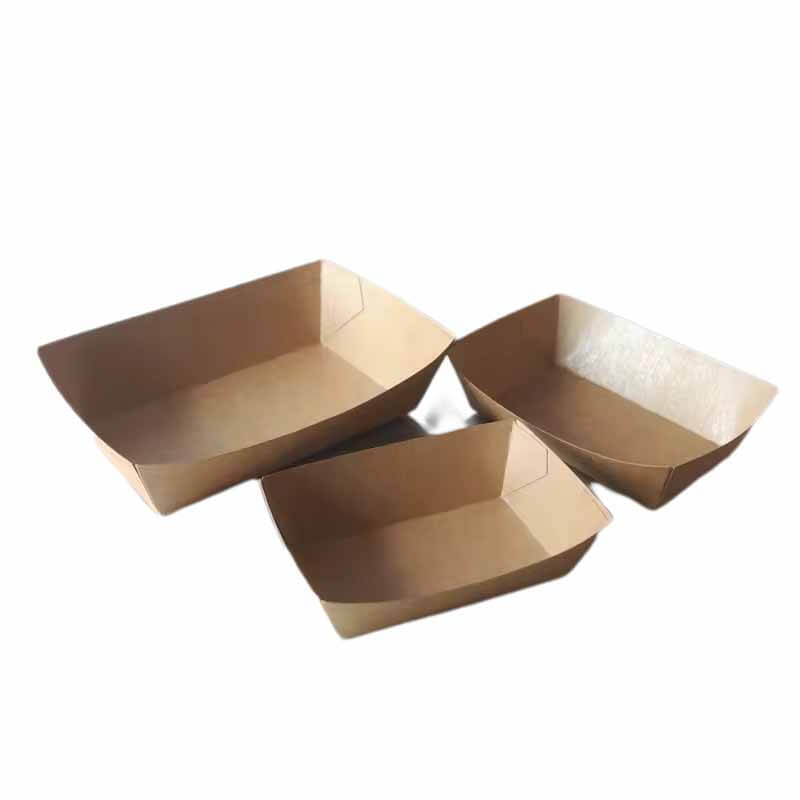
Paper Food Trays
Paper food trays are made from sturdy paperboard materials which are coated for grease resistance or molded pulp materials. They are normally used for holding sandwiches, hamburgers, fries, and snacks, the paperboard material can hold heavier food while the mold pulp food tray is environmentally friendly.
What are the Common Paper Food Tray Sizes
- 5 inches by 7 inches are suitable for small and light snacks, such as nuts, candies, and cookies.
- 6 inches by 9 inches are suitable for fries, onion rings, sandwiches and burgers.
- 8 inches by 10.5 inches are suitable for full meals.
What Factors Affect the Size of Paper Food Trays?
- Food Type: The size of the food paper tray served for candy must be different from the tray served for hamburgers.
- Food Quantity: Food quantity is one of the factors to determine the food tray size, as a small food tray is used for a small quantity of food and a large food tray is used for a large quantity of food.
- Business Type: The food tray size needed by a sit-down restaurant may be different from the restaurant that is only open for to-go or delivery business.
- Storage Space: If you don’t have enough space for storage, you may need a small-size food tray.
The Advantages of Paper Food Trays
You can see the existence of paper snack trays in many snack and takeaway businesses. They must be used so widely, and they must have many advantages!
Eco-Friendly
Paper snack trays are made from renewable resources, they are biodegradable, compostable, and recyclable. They are designed to replace the plastic and Styrofoam trays which were widely used in the past.
Versatility
The paper lunch tray can be designed into various sizes and shapes to accommodate different sizes and shapes of foods. They can be used in many different scenarios, such as restaurants, food trucks, catering events, etc.
Customizability
If you want to promote your brand name, logo, or restaurant to consumers, you can ask the manufacturer of the paper food tray to customize the information you want to show on it.
Grease Resistance
Most paper food trays are coated with grease-resistant lining, which can prevent oil or greasy food from spilling. With the coating, the tray can easily hold the fried or saucy dishes.
Convenience
The kraft paper food trays are lightweight and stackable, easy to transport and store. They also don’t require cleaning, making them very convenient for both users and restaurants.
Cost-Effective
The paper food trays are also more affordable than plastic and Styrofoam food trays, so they are a great alternative without compromising the quality.
Safe and Hygienic
The disposable paper tray is safe for food contact and all manufacturers should produce comply with food safety regulations. They are not reused, which makes them very hygienic.
The Disadvantages of Paper Food Trays
After understanding the pros of paper food trays, let us have a look at their cons.
Limited Durability
Paper food trays can replace plastic and Styrofoam food trays in many aspects, but they are not strong enough to hold hot and moist foods, they easily become soggy and lose their shapes.
Limited Insulation
Paper food tray is not a good replacement when you need to keep the hot foods hot and cold foods cold for a long period of time. So, for the temperature sensitivity items, it is a not good choice.
Environmental Impact of Coatings
Some of the coating used for grease resistance or water resistance in the paper lunch tray may affect its environmental features.
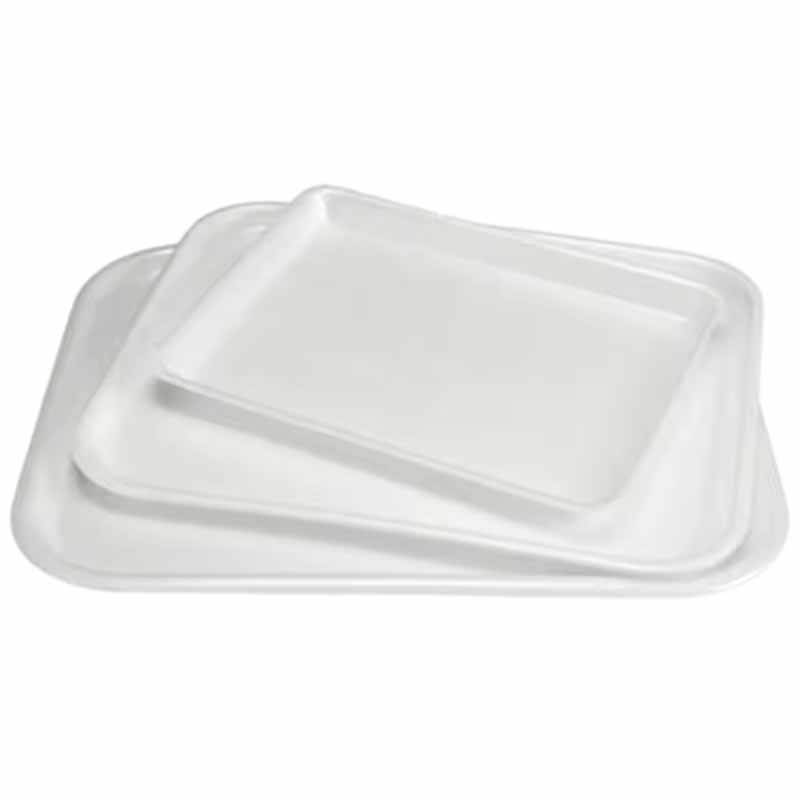
Foam Trays
Foam trays, usually made of expanded polystyrene (EPS), are lightweight and insulating, making them suitable for hot and cold foods. This type of disposable foam food tray is suitable for fast food items, deli meats, and fresh produce.
What are the Common Foam tray sizes?
Foam food trays also can be customized into various sizes and shapes according to specific needs. Here are some commonly used sizes:
- Small foam food trays measure around 6 inches by 6 inches (15 cm by 15 cm) or 8 inches by 8 inches (20 cm by 20 cm).
- Medium foam trays for food measure around 9 inches by 9 inches (23 cm by 23 cm) or 10 inches by 10 inches (25 cm by 25 cm).
- Large Styrofoam food trays measure around 9 inches by 12 inches (23 cm by 30 cm) to 12 inches by 16 inches (30 cm by 41 cm).
- Extra-large Styrofoam trays measure around 16 inches by 20 inches (41 cm by 51 cm) or larger.
The Advantages of Foam Trays
Although the foam trays are not biodegradable, there are still some applications that use them a lot because they have their own advantages.
Insulation
If the food you need to deliver is hot food or cold food and you need to keep the food temperature during transportation, using Styrofoam trays is a good choice.
Lightweight
Foam trays are lightweight, easy to take, safe, and convenient for transportation.
Shock Absorption
Disposable foam food trays have a cushioning effect to help protect foods from damage during transportation. The shock absorption is especially good for transporting pastries, desserts, or delicate fruits, keeping them maintain their original state when arrive at the destination.
Moisture Resistance
The foam food trays are resistant to moisture, which is a great feature to keep the food fresh and prevent leaks.
Versatility
The foam trays for food can be customized into various shapes and sizes to fit different application scenarios.
Cost-Effective
The Styrofoam food trays are cost-effective compared to many other materials, such as aluminum foil, sugarcane fiber, PLA, etc.
Customizability
You can customize your logo, brand name, and labels on the Styrofoam tray to promote your business.
Recyclability
In some countries and areas, where equipped with the corresponding recycling and processing equipment, the Styrofoam tray can be recycled through advanced technology.
The Disadvantages of Foam Trays
Although this material is used for some food packing, it still has some disadvantages you need to know.
Environmental Impact
A well-known disadvantage of Styrofoam trays is their impact on the environment. They are not biodegradable and need hundreds of years to decompose in landfills. If disposed of improperly, it can have a significant impact on the environment.
Potential Health Risks
When the foam food trays contact with hot foods and hot liquids, harmful chemicals like styrene will go into the food and harm your health.
Lack of Sturdiness
The disposable foam food trays are easy to deform or break during the process of stacking, transportation, and handling, but they aren’t as strong as plastic ones.
Regulatory Restrictions
To protect the environment and health, some areas have enacted regulations prohibiting the use of foam food trays. If your business is still using these trays, be careful.
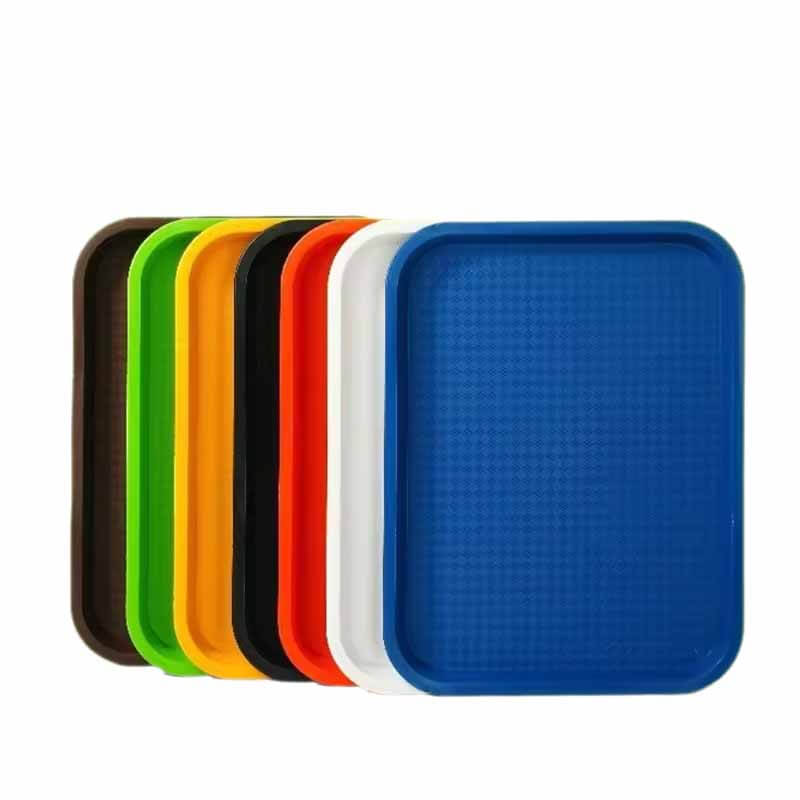
Plastic Food Trays
Plastic trays are commonly used in cafeterias and restaurants for serving and carrying food items. They are made from made from polypropylene (PP) or polyethylene (PE) plastic materials and do not contact food directly. They are normally used for transporting multiple dishes at once.
What are the Common Plastic Food Trays Sizes
The size of plastic food trays depends on the use. However, let us still take a look at the general size for some applications.
Standard Cafeteria Trays
These trays are normally measuring around 4 inches (35.6 cm) in width and 18 inches (45.7 cm) in length. This design is based on that you can use it to hold main dishes, side dishes, and drinks.
Fast Food Trays
Fast food trays measure around 12 inches (30.5 cm) in width and 16 inches (40.6 cm) in length. Just a little bit smaller than standard cafeteria trays and are used to hold hamburgers, sandwiches, fries, and drinks.
Compartment Trays
The compartment trays normally measure around 10 inches (25.4 cm) by 14 inches (35.6 cm) or 12 inches (30.5 cm) by 16 inches (40.6 cm).
Bakery Trays
Bakery tray size normally depends on the size and quantity of the bakery. Normally ranging from small (around 9 inches by 13 inches) to large (around 18 inches by 26 inches).
The Advantages of Plastic Food Trays
Let’s take a look at this indirect food contact tray and what benefits it has!
Durability
They are durable and can withstand frequent use without breaking or cracking. They are impact-resistant and will not be easily damaged even if they are treated roughly by buffet servers and customers.
Lightweight
The clear plastic food tray is lightweight and easy to carry, a good choice for consumers when they are in the cafeteria and need to take multiple foods across large dining areas.
Versatility
Plastic serving trays are flat, compartmentalized, or stackable, which means they can be used in various food presentation and serving scenarios.
Ease of Cleaning
This type of tray is very easy to clean, water stains, oil stains, and stains are all easily gone by rinsing them under the faucet. Of course, you can also put them in the dishwasher.
Reusable and Recyclable
These food trays can be reused many times until they break. After you clean them, they can be recycled in the recycling equipment.
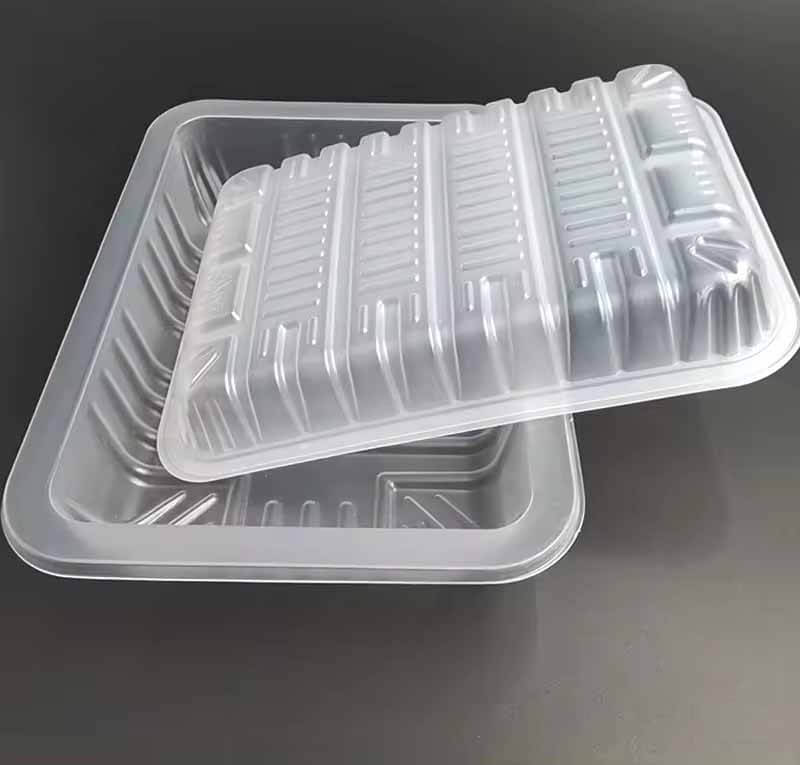
PLA Trays
PLA trays are food trays made from polylactic acid (PLA), a biodegradable and compostable thermoplastic derived from renewable resources such as corn starch, sugarcane, or other plant-based materials. Its appearance replaces the traditional plastic food trays on the market.
What are the Common PLA Trays Sizes
They are used to packing foods, such as sushi, vegetables, and fruits, with no fixed sizes, but can be customized according to your specific needs.
The Advantages of PLA Trays
- Biodegradability: PLA trays are compostable and can break down naturally, reducing environmental pollution.
- Renewable Source: PLA is derived from renewable resources such as corn starch or sugarcane, you can get these materials by planting and they are also not complicated to plant and grow.
- Versatility: PLA trays look similar to the plastic food trays. They also have a transparent appearance, allowing consumers to see what food is inside the tray.
- Environmental Responsibility: The PLA trays are environmentally friendly products, which will give eco-conscious consumers a good impression of your business.
The Disadvantages of PLA Trays
- Composting Requirements: Although the material is biodegradable and compostable, not all countries and areas have specific composting facilities. As a result, many problems will arise when handling PLA trays.
- Cost: PLA trays can be more expensive than plastic trays, due to the cost of sourcing raw materials and production.
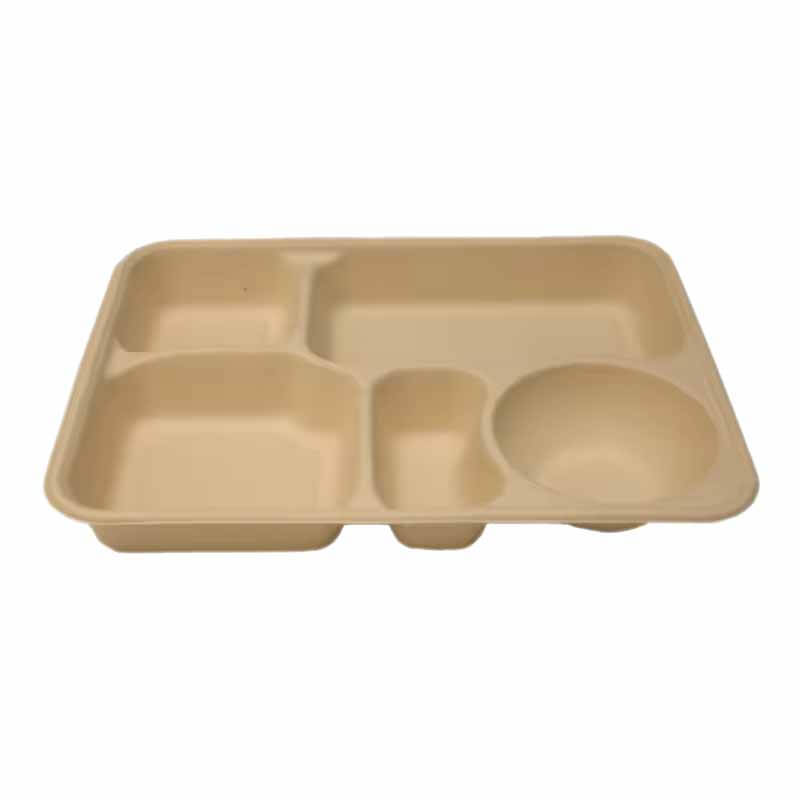
Compostable Trays
Compostable trays are made from molded pulp, and bagasse (sugarcane fiber), this tray is sturdy, biodegradable, and compostable, suitable for holding cold and hot food.
What are the Common Compostable tray sizes?
Compostable trays can be divided into a single compartment, 4 compartments, 5 compartments, and 6 compartments. These are widely used sizes and served for meals. Regarding the other sizes and shapes of biodegradable lunch trays, you can custom from us.
The Advantages of Compostable Trays
Compostable trays are made from sugarcane fiber, which is 100% eco-friendly. With this material, using disposable tableware is no longer a major problem of environmental pollution. Let’s see its benefits.
Biodegradability
Bagasse is a byproduct of sugarcane, which is 100% natural. So, food trays made in this material must be biodegradable and can break down very quickly, without harming the environment.
Renewable Resource
Sugarcane is an annual crop and a rapidly renewable resource. Using bagasse to make the compost trays will reduce the need to use finite fossil fuels, and support the global goals of sustainable development.
Compostability
Compostable food trays made from sugarcane fiber can be composted with other organic waste together in commercial composting facilities. They can break down within 60 days and improve the soil quality.
You may interested in how to compost food waste in restaurants.
Sturdiness
The compostable lunch trays are sturdy enough to hold various foods, widely used in fast-food restaurants, cafeterias, school canteens, hospital canteens, etc.
Microwave and Freezer Safe
The bagasse trays can hold both cold and hot foods, they can also be put in the refrigerator and microwave.
Customizable
The sugarcane trays can be customized into various sizes. If you want to promote your restaurant brand or logo, customization service in our company is also available.
Eco-Friendly Image
Convey to society and those who are environmentally aware that your restaurant is clean, hygienic, safe, has the same values as them and is also making its own contribution to the cause of environmental protection.
The Disadvantages of Compostable Trays
There are still some cons of the compostable trays you need to know as below.
Moisture Sensitivity
The bagasse food trays are single-use products, so we do not suggest holding the food for a long time. Especially products with moisture should not be left for too long, otherwise the tray will become soft or lose structural integrity.
Cost
Using the bagasse, as the raw material to produce the disposable food trays must need a higher cost than the plastic material. If you do not have enough budget, this is not a good choice for you. But, never forget, you are contributing to protecting the environment and reducing disposable pollution.
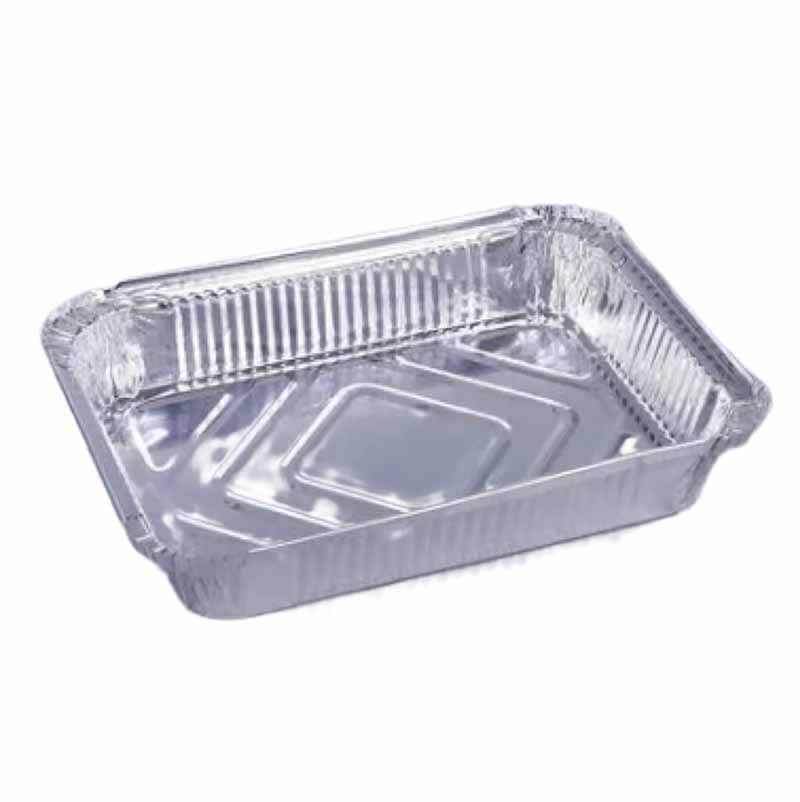
Aluminum Foil Trays
Aluminum foil trays are lightweight and heat resistant, widely used for baking and roasting. The aluminum foil material can keep the food temperature inside the tray.
What are the Common Aluminum Foil Trays Sizes
- Small aluminum foil trays are used for preparing side dishes and desserts.
- Medium aluminum foil trays are used for preparing family-sized meals.
- Large aluminum foil trays are used for preparing bulk cooking and catering.
The Advantages of Aluminum Foil Trays
- Versatility: Aluminum cooking pans can be customized into various sizes and shapes to meet different requirements. They are also very versatile, whether you use them to bake bread or stew curry soup.
- Temperature Stability: The aluminum disposable pans can keep the temperature inside the pans, whether you use them to hold cold food or hot food, you can also put them in the refrigerator, this is a great food tray for both cooking and storage.
- Heat Conductivity: Due to the aluminum foil pan has excellent heat conductivity, so when you are cooking or reheating the food inside the pan, this material allows the heat distribution evenly.
- Lightweight and Portable: The disposable aluminum pans are lightweight and portable, so it is very convenient to take, and suitable for catering, picnics, parties, and other events.
- Non-reactive: Aluminum foil is non-reactive, so it will not affect the food flavor and does not have any odors, even if you heat it.
- Recyclability: The foil pan is 100% recyclable, which is great for our environment. But before recycling them, they must be treated and cleaned properly.
- Healthiness: According to many studies, using aluminum pans to cook, heat, and store food, there is no harmful element that will affect our health.
The Disadvantages of Aluminum Foil Trays
- Limited Stiffness: The aluminum foil trays are not as strong as plastic ones, especially for the large and extra large foil pans, they are easy to bendable, so you need to be careful when you take them.
- Cost: According to the market price and production cost, aluminum pans are less affordable than plastic food trays.
How to Choose the Right Disposable Food Trays for Your Business?
Choosing the proper type of disposable food trays will benefit your business a lot, here are some factors you need to consider.
Food Type
Different types of food will affect the food tray type. For example, if you use them to serve hot and cold food, and also need to keep the temperature, choosing Foam trays and aluminum foil trays can meet your request.
Think About Presentation
For display purposes, you may need a food tray with transparent lids. Now, you can use, plastic food trays, PLA food trays, and compostable food trays.
Convenience
All disposable food containers are easy to carry, but using disposable compartment food trays is more convenient than food trays without compartments. Since you can put multiple foods together and they will not mix.
Durability
Combined with the characteristics and weight of your food, choose a disposable tray suitable for your food.
Environmental Considerations
For convenience, people use a large number of disposable food trays, but similarly, we cannot pollute the environment at any expense. So, we need to choose food packaging containers that are good for the environment to run a restaurant. For example, biodegradable food tray, paper trays, aluminum foil trays, etc.
Cost
Consider the cost of the food tray, it needs to fit your budget. Also, you need to consider the quality of the disposable food tray to meet your needs.
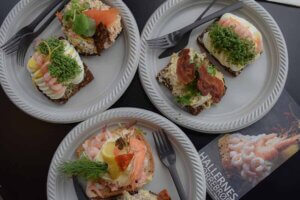
John Q
John Q is Eco March’s Product Manager. With 5 years of prior experience in the food industry after graduating from university, he has been an integral part of Eco March. He excels in creating and developing eco-friendly food packaging products with a keen focus on enhancing the consumer experience.


